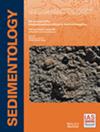伊朗西北部乌尔米亚湖近5万年来的沉积演化与湖泊水位波动从青蒿粪便颗粒记录的见解
IF 2.8
2区 地球科学
Q1 GEOLOGY
引用次数: 0
摘要
利用Artemia粪便颗粒的丰度和组成特征,研究了伊朗西北部高盐Urmia湖25 m长的沉积物岩心的晚第四纪沉积史和古气候变化。沉积物分析由扫描电子显微镜-能量色散x射线光谱,有机和无机碳含量测量以及粪便颗粒碳酸盐的稳定同位素(δ13C和δ18O)支持。从粪便颗粒和大量沉积物中获得的10个放射性碳年龄支持了岩心回溯到50 kyr bp的不精确年代学。古环境记录可划分为四个时期:(1)在海洋同位素阶段3的大部分时期,湖平面下降的特征是粪便颗粒数量减少,而包裹颗粒、硫酸盐矿物和重新加工的贝壳碎片数量增加。(ii)在晚期的海洋同位素第3阶段和早期的海洋同位素第2阶段,湖泊水位低洼和湖底暴露是根据相对较低丰度的颗粒来解释的,这些颗粒是五颜六色的,与火山岩屑和圆形硫酸盐矿物一起出现。(iii)在晚期的海洋同位素阶段2,记录中没有颗粒,但主要是大的硫酸盐晶体,表明湖平面长期处于低水平。(iv)在海洋同位素阶段1,一个相对的湖泊水位高地迅速建立起来,沉积物中含有大量的新鲜颗粒。现代的湖平面低洼以盐壳为代表。从粪便颗粒碳酸盐中测量的δ13C和δ18O记录表明,随着时间的推移,湖泊的降水与蒸发平衡有关。从下到上向负δ值的线性趋势说明了从晚更新世到全新世到达湖泊的降水量增加。晚更新世的两个显著的同位素极小值和全新世早期的一个显著的同位素极小值标志着相对较高的湖泊水位,这也与土耳其的凡湖有关。本文章由计算机程序翻译,如有差异,请以英文原文为准。
Sedimentary evolution and lake level fluctuations of Urmia Lake (north-west Iran) over the past 50 000 years; insights from Artemia faecal pellet records
A 25 m long sediment core from hypersaline Urmia Lake (north-west Iran) was studied for the Late Quaternary depositional history and palaeoclimate variations using the abundance and compositional characteristics of Artemia faecal pellets. Sediment analysis is supported by scanning electron microscopy – energy dispersive X-ray spectroscopy, organic and inorganic carbon content measurements, and stable isotopes (δ13C and δ18O) from faecal pellet carbonates. The imprecise chronology of the core back to 50 kyr bp is supported by ten radiocarbon ages from faecal pellets and bulk sediments. The palaeoenvironmental record is subdivided into four periods: (i) During much of Marine Isotope Stage 3, a period of lake level lowering is characterized by a decreasing amount of faecal pellets, and an increasing amount of coated grains, sulphate minerals and reworked shell fragments. (ii) During late Marine Isotope Stage 3 and early Marine Isotope Stage 2 a lake level lowstand and a lake floor exposure is interpreted based on the relatively low abundance of pellets, which are multicoloured and appear together with volcanic lithics and rounded sulphate minerals. (iii) During late Marine Isotope Stage 2 the record is devoid of pellets but dominated by large sulphate crystals suggesting a prolonged low lake level. (iv) During Marine Isotope Stage 1 a relative lake level highstand is rapidly established with sediments that are highly abundant in fresh pellets. The modern lake level lowstand is represented by a salt crust. The δ13C and δ18O records measured from faecal pellet carbonates suggest a link with the precipitation versus evaporation balance in the lake over time. From bottom to top the linear trend towards more negative delta values illustrates the increasing amount of precipitation arriving at the lake from the Late Pleistocene to the Holocene. Two prominent isotope minima during the Late Pleistocene and one prominent minimum in the early Holocene mark relative high lake levels, which can also be linked to Lake Van in Turkey.
求助全文
通过发布文献求助,成功后即可免费获取论文全文。
去求助
来源期刊

Sedimentology
地学-地质学
CiteScore
8.20
自引率
11.40%
发文量
94
审稿时长
6-12 weeks
期刊介绍:
The international leader in its field, Sedimentology publishes ground-breaking research from across the spectrum of sedimentology, sedimentary geology and sedimentary geochemistry.
Areas covered include: experimental and theoretical grain transport; sediment fluxes; modern and ancient sedimentary environments; sequence stratigraphy sediment-organism interaction; palaeosoils; diagenesis; stable isotope geochemistry; environmental sedimentology
 求助内容:
求助内容: 应助结果提醒方式:
应助结果提醒方式:


